Microplastic sizes in Hudson-Raritan Estuary and coastal ocean revealed
Rutgers research shows stormwater could be important source of plastic pollution
2021-03-01
(Press-News.org) Rutgers scientists for the first time have pinpointed the sizes of microplastics from a highly urbanized estuarine and coastal system with numerous sources of fresh water, including the Hudson River and Raritan River.
Their study of tiny pieces of plastic in the Hudson-Raritan Estuary in New Jersey and New York indicates that stormwater could be an important source of the plastic pollution that plagues oceans, bays, rivers and other waters and threatens aquatic and other life.
"Stormwater, an understudied pathway for microplastics to enter waterways, had similar or higher concentrations of plastics compared with effluent from wastewater sewage treatment plants," said senior author Nicole Fahrenfeld, an associate professor in the Department of Civil and Environmental Engineering in the School of Engineering at Rutgers University-New Brunswick. "More research is needed to increase understanding of the full impact of microplastics on ecosystems."
In the early 1900s, General Bakelite began manufacturing Bakelite, the first synthetic plastic on Earth, in Perth Amboy, New Jersey. Today, plastics are used in myriad products worldwide and are widespread in marine and other environments, posing risks to wildlife and aquatic life.
Possible sources of microplastics - often fragments of larger pieces of plastic - include municipal, industrial and stormwater outfalls.
The Rutgers team collected water samples during a relatively dry period in July 2018 and after a heavy rainfall in April 2019. They also collected samples of wastewater entering treatment plants, wastewater discharges and stormwater.
The highest levels of microplastics, ranging from two-hundredths of an inch to less than a tenth of an inch long, were observed during summer low-flow conditions at the mouth of the Raritan River, according to the study in the journal Chemosphere. Higher concentrations of smaller microplastics collected from Raritan Bay and the Atlantic Ocean off New Jersey likely came from the Hudson River, according to Fahrenfeld.
"The smaller microplastics likely spent more time in the turbulent Hudson River, leading to increased aging and breakdown of plastics," she said.
Polyethylene, which is widely used in high-density polyethylene bottles, trash bags and other items, was the most commonly observed polymer, or plastic, in the Raritan River and Hudson-Raritan Estuary.
A 2017 Rutgers-led study found high levels of microplastics in the Raritan and Passaic rivers. Scientists later identified more than 300 organic chemical compounds that appeared to be associated with microplastic particles in the two rivers.
INFORMATION:
The lead author of the new study is Kendi Bailey, who earned a master's degree at Rutgers-New Brunswick. Other authors include Rutgers University-Camden graduate student Karli Sipps, Rutgers-New Brunswick Professor Grace K. Saba, Rutgers-Camden Professor Georgia Arbuckle-Keil and Rutgers-New Brunswick Professor Robert J. Chant.
[Attachments] See images for this press release:

ELSE PRESS RELEASES FROM THIS DATE:
2021-03-01
DALLAS, March 1, 2021 — Studies representing nearly 2 million adults worldwide show that eating about five daily servings of fruits and vegetables, in which 2 are fruits and 3 are vegetables, is likely the optimal amount for a longer life, according to new research published today in the American Heart Association’s flagship journal Circulation.
Diets rich in fruits and vegetables help reduce risk for numerous chronic health conditions that are leading causes of death, including cardiovascular disease and cancer. Yet, only about one in 10 adults eat enough fruits or vegetables, according to the U.S. Centers for Disease Control and Prevention.
“While groups like the ...
2021-03-01
A new method, described in a study published today in the journal Nature Communications, has the potential to boost international research efforts to find drugs that eradicate cancer at its source.
Most cancerous tissue consists of rapidly dividing cells with a limited capacity for self-renewal, meaning that the bulk of cells stop reproducing after a certain number of divisions. However, cancer stem cells can replicate indefinitely, fuelling long-term cancer growth and driving relapse.
Cancer stem cells that elude conventional treatments like chemotherapy are one of the reasons ...
2021-03-01
With eight months to go before the UN Climate Change Conference (COP26), an international survey experiment has found evidence of "overwhelming" support across seven major countries for governments to "do more" to protect the environment.
The survey directly asks the public about policies they want to see backed by governments at COP26, when the UK and Italy will gather world leaders in Glasgow from 1 November to commit to urgent global climate action.
Researchers at the University of Cambridge worked with polling agency YouGov on a message-testing experiment involving 14,627 adults, with ...
2021-03-01
Diversity, equity and inclusion (DEI) leaders in academic medicine are subject to increasing expectations with limited resources and there is an urgent need for psychiatry departments to commit to fully supporting their efforts, according to an article now available in the American Journal of Psychiatry written by top DEI leaders in academic psychiatry from across the country.
The authors, representing prominent public and private institutions, include Ayana Jordan, M.D., Ph.D., Yale University, and current APA ECP Trustee-at-Large; Ruth S. Shim, M.D., M.P.H. University ...
2021-03-01
BINGHAMTON, NY - Several proposals have emerged on how to distribute the COVID-19 vaccine, but they fall short in ensuring that the vaccine is distributed fairly. A team including Binghamton University professor Nicole Hassoun suggests three ways to more fairly and effectively distribute the vaccine so that people in poor countries get the vaccine as soon as possible.
"Although many people in rich countries will receive a vaccine for COVID-19 this year, many people in poor countries will likely have to wait years to get one," said Hassoun. "Ethical vaccine allocation requires closing this gap and ensuring that everyone can access a vaccine ...
2021-03-01
PHILADELPHIA-- Hospital emergency departments (EDs) not only care for patients with overdose and other complications from opioid use, but they also serve as vital touch points to engage patients into longer-term treatment. After an overdose, patients are at risk for repeat overdose and death. Pennsylvania is unique in establishing a voluntary incentive program to improve the rate at which patients with opioid use disorder receive follow-up treatment after emergency department care. Evaluations of the program show that financial incentives are effective in producing rapid treatment innovations for opioid use disorder.
In a study, researchers at the Perelman School of Medicine at ...
2021-03-01
Oak Brook, IL - The March edition of SLAS Discovery features the cover article, "Therapeutic and Vaccine Options for COVID-19: Status After 6 Months of the Disease Outbreak" by Christian Ogaugwu (Federal University Oye-Ekiti, Ekiti State, Nigeria ), Dawid Maciorowski, Subba Rao Durvasula, Ph.D., Ravi Durvasula, M.D., and Adinarayana Kunamneni, Ph.D. (Loyola University Medical Center, Maywood, IL, USA).
This cover article focuses on the therapeutic and vaccine options available against the novel coronavirus, roughly six months after the outbreak; because the COVID-19-related death toll worldwide had reached 500,000 in six months (and ballooned to over 2,000,000 at the time of publishing) the importance of options to temper the disease cannot be overemphasized. The article ...
2021-03-01
Major changes in bereavement care have occurred during the COVID-19 pandemic, amid a flood of demand for help from bereaved people, according to new research from the University of Cambridge. The first major study of pandemic-related changes in bereavement care has found that the switch to remote working has helped some services to reach out, but many practitioners feel they do not have capacity to meet people's needs.
It is estimated that for every death, nine people are affected by bereavement. The scale of the impact of the COVID-19 pandemic on those ...
2021-02-28
MINNEAPOLIS - Obstructive sleep apnea is when breathing is repeatedly interrupted during sleep. Research has shown people with this sleep disorder have an increased risk of developing cognitive impairment and Alzheimer's disease. Yet, it is treatable. A preliminary study released today, February 28, 2021, has found that obstructive sleep apnea is common in people with cognitive impairment. The study will be presented at the American Academy of Neurology's 73rd Annual Meeting being held virtually April 17 to 22, 2021.
Cognitive impairment includes memory and thinking problems that affect ...
2021-02-28
Red supergiants are a class of star that end their lives in supernova explosions. Their lifecycles are not fully understood, partly due to difficulties in measuring their temperatures. For the first time, astronomers develop an accurate method to determine the surface temperatures of red supergiants.
Stars come in a wide range of sizes, masses and compositions. Our sun is considered a relatively small specimen, especially when compared to something like Betelgeuse which is known as a red supergiant. Red supergiants are stars over nine times the mass of our sun, and all this mass means that when they die they do so with extreme ferocity in an enormous explosion known as a supernova, in particular what is known as a Type-II supernova.
Type II supernovae seed the cosmos with elements ...
LAST 30 PRESS RELEASES:
[Press-News.org] Microplastic sizes in Hudson-Raritan Estuary and coastal ocean revealed
Rutgers research shows stormwater could be important source of plastic pollution


